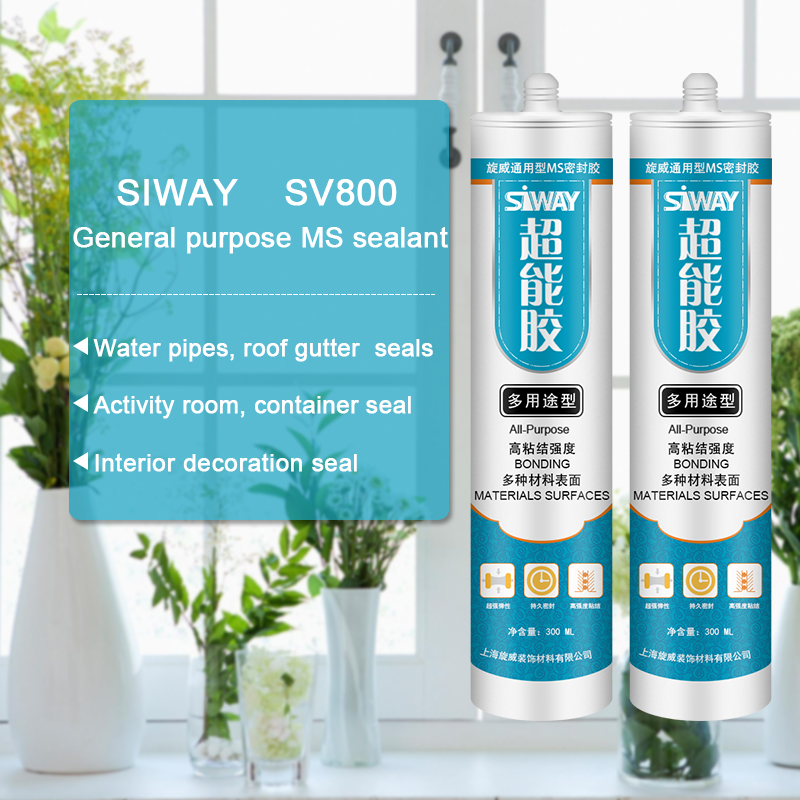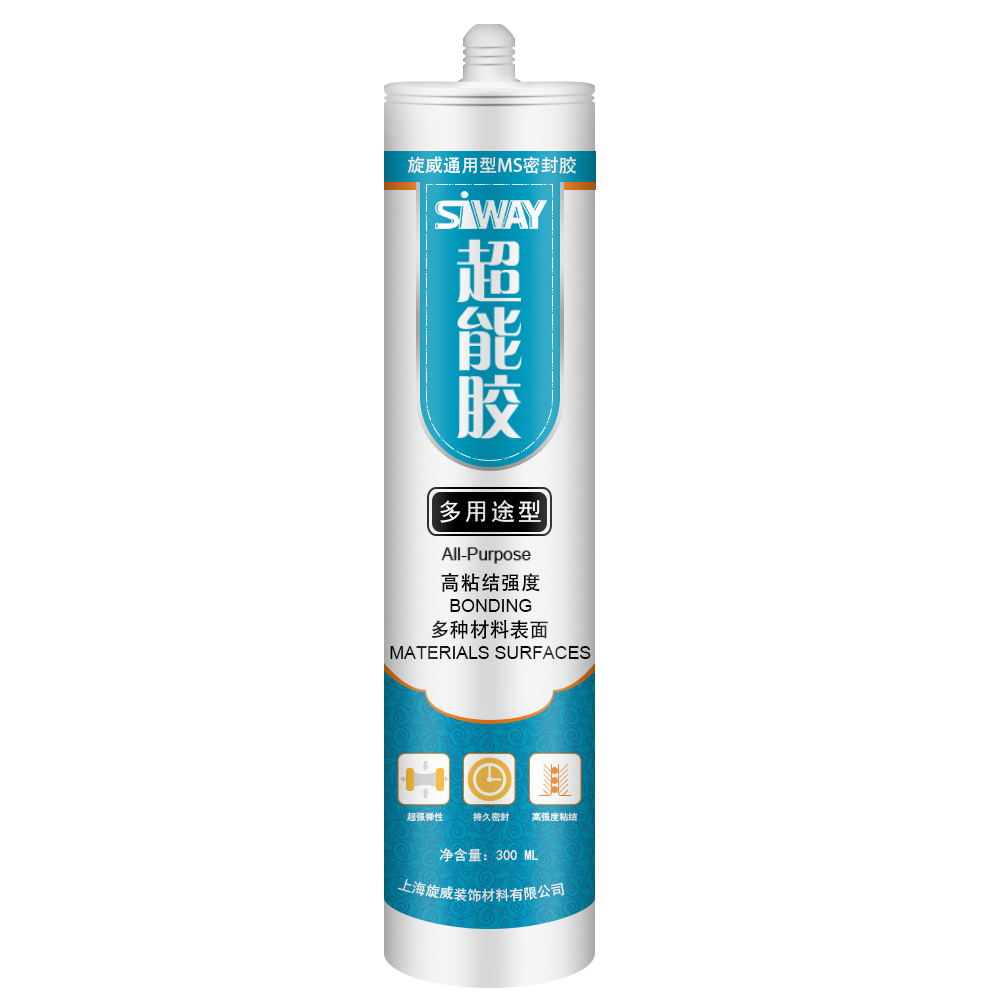Good Wholesale Vendors SV-800 General purpose MS sealant Supply to India
Short Description:
Description General purpose and low modulus MSALL sealant is a high quality, single component, paintable, anti-polluting neutral modified sealant based on silane-modified polyether polymers. The product does not contain solvents, no pollution to the environment, while most of the building materials, without primer, can produce superior adhesion. Product Features 〔1〕 environmental protection products: no solvent, no PVC, no isocyanate, non-toxic, tasteless, non-polluting, fast curing;...
Our development depends on the advanced equipment, excellent talents and continuously strengthened technology forces. Good Wholesale Vendors SV-800 General purpose MS sealant Supply to India, "Create Values,Serving Customer!" is the aim we pursue. We sincerely hope that all customers will establish long term and mutually beneficial cooperation with us.If you wish to get more details about our company, Please contact with us now
Description
General purpose and low modulus MSALL sealant is a high quality, single component, paintable, anti-polluting neutral modified sealant based on silane-modified polyether polymers. The product does not contain solvents, no pollution to the environment, while most of the building materials, without primer, can produce superior adhesion.
Product Features
〔1〕 environmental protection products: no solvent, no PVC, no isocyanate, non-toxic, tasteless, non-polluting, fast curing;
[2] surface coating: compatible with most industrial paint, dry surface can be painted, so does not affect the curing speed;
[3] easy to use: excellent thixotropy and extrusion, for a wide temperature range.
〔4〕 good adhesion: the stone, aluminum, ceramics and cement components, and most of the building materials with excellent adhesion properties; no pollution of the porous material.
[5] excellent weather resistance, aging performance, superior tensile and compression resilience;
[6] neutral curing, stone, cement and other non-corrosive building materials, to overcome the common silicone rubber easy to contaminate the shortcomings of the substrate.
Basic use
General purpose and low modulus MSALL sealant Suitable for use:
[1] construction of housing and other areas of bonding and sealing;
[2] fixed panel, frame, window sill installation, suitable for a variety of building materials such as paint metal, glass, wood, concrete, stone, masonry and other ordinary seal;
[3] seam and ceiling seal;
[4] water pipes, roof gutter and other seals;
[5] activity room, container seal;
[6] interior decoration seal;
[7] mildew – suitable for kitchen and toilet applications;
〔8〕 the floor system of bonding, especially for housing renovation when the laying of tiles;
[9] on the porous material or smooth, moist surface has a strong adhesive force.
[10] Please note: MSALL sealant is not suitable for glass inlay use; for the prefabricated concrete displacement joint seal recommended supporting the use of Jiang special primer.
Technical data sheet
| Test standard | Test project | Unit | value |
| Before curing——25℃,50%R.H. | |||
| GB13477 | density | g/m³ | 1.40±0.05 |
| GB2793 | Non-volatile components | % | 99.5 |
| GB13477 | Flow, sagging or vertical flow | mm | 0 |
| GB13477 | surface drying time(25℃,50%R.H.) | min | 45-60 |
| Curing speed | mm/24h | 3 | |
| Sealant curing speed and operating time will have different with different temperatures and temperature, high temperature and high humidity can make sealant curing speed faster, rather low temperature and low humidity are slower.
14days after curing——25℃,50%R.H. |
|||
| GB13477 | Durometer Hardness | Shore A | 22-28 |
| GB13477 | The ultimate tensile strength | Mpa | 1.0 |
| GB13477 | elongation at break | % | 550 |
Color
White, black, grey
Package
300ml plastic cartridges
Shelf life
12 months
Note
If you want the TDS or MSDS or other details, please contact with our sales person.
What is CEMENT BOARD? What does CEMENT BOARD mean? CEMENT BOARD meaning – CEMENT BOARD definition – CEMENT BOARD explanation.
Source: Wikipedia.org article, adapted under https://creativecommons.org/licenses/by-sa/3.0/ license.
cement board is a combination of cement and reinforcing fibers formed into 4 foot by 8 foot sheets (or 3 foot by 5 foot sheets), 1/4 to 1/2 inch thick that are typically used as a tile backing board. Cement board can be nailed or screwed to wood or steel studs to create a substrate for vertical tile and attached horizontally to plywood for tile floors, kitchen counters and backsplashes. It can be used on the exterior of buildings as a base for exterior plaster (stucco) systems and sometimes as the finish system itself.
Cement board adds impact resistance and strength to the wall surface as compared to water resistant gypsum boards. Cement board is also fabricated in thin sheets with polymer modified cements to allow bending for curved surfaces.
Cement boards are mainly cement bonded particle boards and cement fibre. Cement bonded particle boards have treated wood flakes as reinforcement, whereas in cement fibre boards have cellulose fibre, which is a plant extract as reinforcement. Cement acts as binder in both the cases. The fire resistance properties of cement bonded blue particle boards and cement fibre boards are the same. In terms of load-bearing capacity, cement-bonded particle boards have higher capacity than cement fibre boards. Cement particle boards can be manufactured from 6 mm to 40 mm thickness making it ideally suitable for high load bearing applications. These boards are made of a homogeneous mixture and hence are formed as single layer for any thickness. Cement fibre boards are more used in decorative applications and can be manufactured from 3 mm to 20 mm thickness. Fibre boards are made in very thin layers, making it extremely difficult to manufacture high thickness boards. Many manufacturers use additives like mica, aluminium stearate and cenospheres in order to achieve certain board qualities. Typical cement fiber board is made of approximately 40-60% of cement, 20-30% of fillers, 8-10% of cellulose, 10-15% of mica. Other additives like above mentioned aluminium stearate and PVA are normally used in quantities less than 1%. Cenospheres are used only in low density boards with quantities between 10-15%. The actual recipe depends on available raw materials and other local factors.
As a tile backing board, cement board has better long-term performance than paper-faced gypsum core products because it will not mildew or physically break down in the continued presence of moisture or leaks. Cement board is not actually waterproof, but it is highly resistant to absorbing moisture and has excellent drying properties. In areas continually exposed to water spray (i.e. showers) a waterproofing barrier is usually recommended behind the boards or as a trowel-applied product to the face of the boards behind the finish system.
One major disadvantage of cement board is the weight per square foot. It is approximately twice that of gypsum board, making handling by one person difficult. Cutting of cement board must also be done with carbide-tipped tools and saw blades. Due to its hardness, pre-drilling of fasteners is often recommended. Finally, cement board is initially more expensive than water resistant gypsum board but may provide better long term value.
Cement board is hung with corrosion resistant screws or ring-shank nails. Cement board has very little movement under thermal stress, but the boards are usually installed with a slight gap at joints in shower pans, bathtubs, and each other. These joints are then filled with silicone sealant or the manufacturer’s taping compounds before applying a finish. The filled joints are taped like conventional gypsum board, but with fiberglass tapes that provide additional water resistance. Combined with a water impermeable finish, cement board is a stable, durable backing board.
https://www.windowreplacementrepair.com https://www.clearwindowtech.com 314-966-2666
One question I often get asked is why the seals on windows and doors break.
Here’s why. Windows and doors are subjected to harsh elements like extreme temperatures, sunlight, ultraviolet rays, wind, rain, ice and snow. This means that the window glass is constantly expanding and contracting, much like an accordion. The positive and negative forces pull the window glass away from the spacer when it’s cold and they crush the spacer when it’s hot. We call it solar pumping.
Ultraviolet light combines with the heat and cold to gradually weaken the bonding agents that hold the window glass to the spacer. Eventually a pinhole-sized break between the window glass and spacer occurs. Humidity is pulled in through the broken seal in between the two panes of window glass, and it looks like a ‘fog’ that can’t be wiped off.
Replacing failed window seals with new window glass restores the insulating value.
The moist air inside a failed unit isn’t a good insulator, whereas a new unit with dry air is a very effective insulator and saves energy costs.
If you or people you know are in need of window or patio door repair or replacement, I encourage you to check out more videos on our web site www.windowreplacementrepair.com or give us a call at 314.966.2666.







